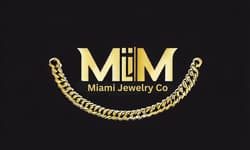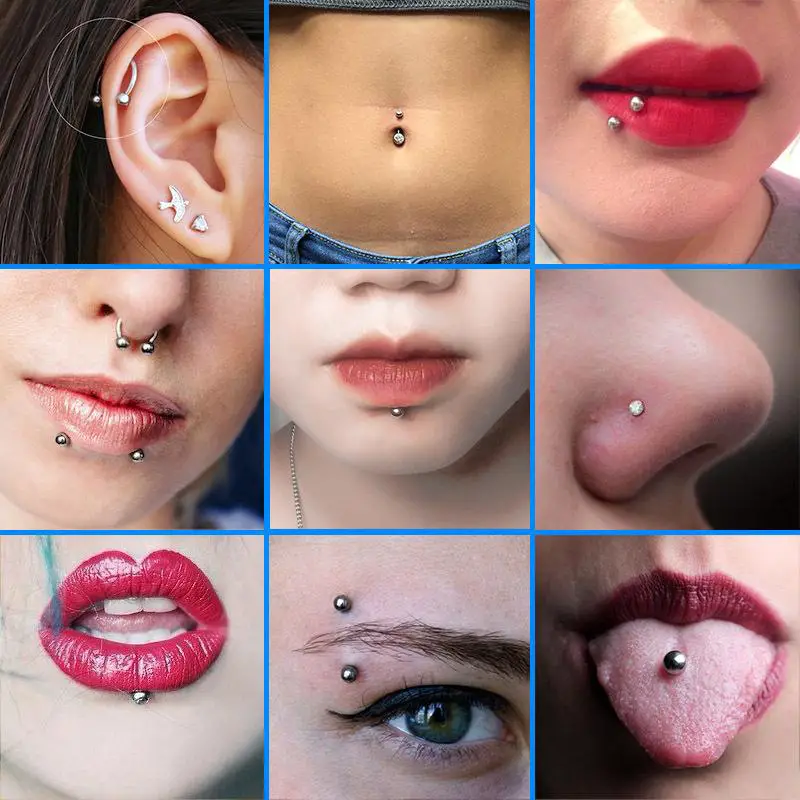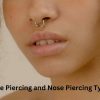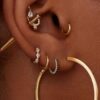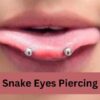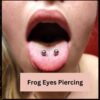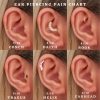Piercing
Body Piercing Process – How Is a Body Piercing Done
If you are thinking of getting a body piercing, you might be wondering how the piercing process works. What are the steps involved? What are the tools used? What are the risks and benefits? How can you prepare yourself for a successful piercing experience?
In this article, I will answer these questions and more. I will explain the piercing process from start to finish, covering different types of piercings, piercing methods, piercing equipment, piercing aftercare, and piercing complications.
By the end of this article, you will have a clear understanding of how a body piercing is done and what you can expect from it.
Contents
What Is a Body Piercing?
A body piercing is a form of body modification that involves creating an opening in the skin or cartilage of a specific body part and inserting a piece of jewelry or an implant into it. The jewelry or implant can be made of various materials such as metal, glass, plastic, wood, stone, or bone.
Body piercings can be done for various reasons such as self-expression, aesthetic enhancement, cultural or religious affiliation, sexual pleasure, or medical necessity. Body piercings can also have different meanings and symbolism depending on the location, style, and history of the piercing.
Some of the most common body piercings are:
- Ear piercings: These include earlobe piercings and various cartilage piercings such as helix, tragus, conch, daith, rook, industrial, orbital, etc.
- Facial piercings: These include eyebrow piercings, nose piercings (nostril or septum), lip piercings (labret, monroe, medusa, etc.), cheek piercings (dimple or anti-dimple), tongue piercings (midline or venom), etc.
- Oral piercings: These include lip frenulum piercings (smiley or frowny), tongue frenulum piercings (web), uvula piercings (the dangling tissue at the back of the throat), etc.
- Body/surface piercings: These include navel piercings (belly button), nipple piercings (male or female), neck piercings (nape or vampire), chest piercings (cleavage or sternum), back piercings (dorsal fin or corset), hip piercings (anti-hip or hip surface), etc.
- Genital piercings: These include male genital piercings such as prince albert (PA), reverse PA (RPA), frenum ladder (Jacob’s ladder), hafada (scrotal), guiche (perineum), dydoe (corona), ampallang (horizontal glans), apadravya (vertical glans), etc., and female genital piercings such as clitoral hood (VCH or HCH), clitoris (rare and risky), inner or outer labia, fourchette (perineal), triangle (under the clitoris), Christina (pubic mound), etc.
How Is a Body Piercing Done?
The piercing process can vary depending on the type and location of the piercing, the piercer’s technique and preference, and the client’s anatomy and comfort level. However, there are some general steps that are usually followed in most piercing procedures. These are:
Step 1: Consultation
Before the actual piercing, the piercer will have a consultation with the client to discuss their piercing goals, expectations, preferences, and medical history. The piercer will explain the piercing process, the risks and benefits, the healing time and aftercare, and the jewelry options. The piercer will also answer any questions or concerns that the client may have.
The piercer will then examine the client’s anatomy and determine the best placement and angle for the piercing. The piercer will also check for any existing piercings, scars, moles, or other factors that may affect the piercing outcome. The piercer will then mark the piercing site with a sterile marker or a toothpick dipped in ink.
The client will have a chance to review and approve the marking before proceeding to the next step. The client will also have to sign a consent form and provide a valid ID if required by law.
Step 2: Preparation
The piercer will then prepare the piercing area by cleaning it with an antiseptic solution such as alcohol or iodine. The piercer will also wash their hands with soap and water and put on a fresh pair of gloves. The piercer will then open a sterile package containing the piercing needle, jewelry, forceps, clamps, or other tools that will be used for the piercing.
The piercer will then insert the jewelry into the needle or attach it to a receiving tube or cork. The piercer will also lubricate the needle and jewelry with a water-based lubricant to reduce friction and pain.
Step 3: Piercing
The piercer will then position the client in a comfortable and stable position that allows access to the piercing site. The piercer may use forceps, clamps, or their fingers to hold the skin or cartilage in place and create tension for a smoother piercing. The piercer will then align the needle with the marking and quickly push it through the tissue until it reaches the other side.
The piercer will then follow the needle with the jewelry or insert it into the needle and pull it through. The piercer will then secure the jewelry with a ball, bead, ring, or other closure. The piercer will then wipe off any blood or excess lubricant with a sterile gauze or cotton swab.
Step 4: Aftercare
The piercer will then explain to the client how to care for their new piercing and provide them with written aftercare instructions. The piercer will also advise them on what to expect during the healing process, such as swelling, redness, tenderness, crusting, itching, secretion, etc.
The piercer will also warn them about potential complications such as infection, inflammation, rejection, migration, keloids, hypertrophic scars, etc., and how to prevent or treat them. The piercer will also recommend they avoid certain activities such as swimming, touching, twisting, changing jewelry, etc. until the piercing is fully healed.
The piercer will then give them a contact number or email address in case they have any questions or concerns later on. The piercer may also schedule a follow-up appointment to check on the healing progress and change jewelry if needed.
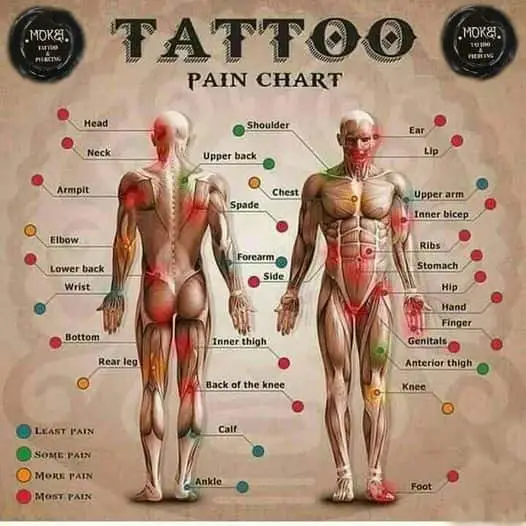
How Long Does It Take for a Body Piercing to Heal?
The healing time of a body piercing depends on several factors such as:
- The type and location of the piercing
- The quality and material of the jewelry
- The skill and technique of the piercer
- The hygiene and aftercare of the client
- The immune system and health condition of the client
- The individual healing rate of each person
Generally speaking, body piercings can be divided into two categories based on their healing time: soft tissue piercings and cartilage piercings.
Soft tissue piercings are those that go through skin or mucous membranes such as earlobes, eyebrows, nostrils, lips, tongue, nipples, navel, genitals, etc. These tend to heal faster than cartilage piercings because they have more blood supply and less resistance.
Cartilage piercings are those that go through hard or semi-hard tissues such as helixes, traguses, conches, daiths, rooks, industrials, etc. These tend to heal slower than soft tissue piercings because they have less blood supply and more resistance.
The following table shows some approximate healing times for common body piercings:
| Piercing | Healing Time |
|---|---|
| Earlobe | 6-8 weeks |
| Helix | 3-6 months |
| Tragus | 3-6 months |
| Conch | 6-9 months |
| Daith | 6-9 months |
| Rook | 6-9 months |
| Industrial | 6-12 months |
| Orbital | 6-12 months |
| Eyebrow | 6-8 weeks |
| Nostril | 2-4 months |
| Septum | 6-8 weeks |
| Lip | 6-8 weeks |
| Labret | 6-8 weeks |
| Monroe | 6-8 weeks |
| Medusa | 6-8 weeks |
| Cheek | 2-3 months |
| Tongue | 4-6 weeks |
| Smiley | 4-6 weeks |
| Frowny | 4-6 weeks |
| Web | 4-6 weeks |
| Uvula | 4-6 weeks |
| Navel | 6-12 months |
| Nipple | 3-6 months |
| PA | 4-8 weeks |
| RPA | 2-3 months |
| Frenum | 2-3 months |
| Hafada | 2-3 months |
| Guiche | 2-3 months |
| Dydoe | 2-3 months |
| Ampallang | 4-6 months |
| Apadravya | 4-6 months |
| VCH | 4-6 weeks |
| HCH | 4-6 weeks |
| Clitoris | 4-6 weeks |
| Inner Labia | 4-6 weeks |
| Outer Labia | 4-6 weeks |
| Fourchette | 4-6 weeks |
| Triangle | 2-3 months |
| Christina | 3-4 months |
These healing times are only estimates and may vary depending on individual factors. It is important to follow the aftercare instructions given by the piercer and to monitor the piercing for any signs of infection or other problems. If in doubt, consult a professional piercer or a doctor.
How to Care for a Body Piercing?
The aftercare of a body piercing is crucial for its healing and longevity. A proper aftercare routine can prevent infection, inflammation, rejection, migration, scarring, and other complications. A poor aftercare routine can cause pain, irritation, swelling, discharge, odor, and other issues.
The basic aftercare of a body piercing involves:
Cleaning
Cleaning the piercing site is essential to remove any dirt, bacteria, crust, or dead skin cells that may accumulate around the jewelry and cause infection or irritation. Cleaning should be done twice a day with a mild saline solution (sea salt and water) or a piercing-specific cleanser. Avoid using harsh chemicals such as alcohol, hydrogen peroxide, iodine, or antibacterial soap as they can dry out and damage the tissue.
To clean the piercing, soak a cotton ball or pad in the saline solution or cleanser and gently dab it on the piercing site. Do not rub or twist the jewelry as this can cause trauma and delay healing. Rinse the area with clean water and pat it dry with a clean paper towel or tissue. Do not use cloth towels as they can harbor bacteria and lint.
Moisturizing
Moisturizing the piercing site is important to keep the tissue hydrated and flexible. Moisturizing can also reduce itching, flaking, and scabbing. Moisturizing should be done once or twice a day with a natural oil such as jojoba, coconut, or emu oil. Avoid using petroleum-based products such as Vaseline or mineral oil as they can clog the pores and trap bacteria.
To moisturize the piercing, apply a few drops of oil on your fingertips and gently massage it into the piercing site. Do not overdo it as this can cause excess oil buildup and attract dirt. Wipe off any excess oil with a clean paper towel or tissue.
Protecting
Protecting the piercing site is vital to prevent any external factors from interfering with the healing process. Protecting can also prevent accidental bumps, snags, pulls, or tears that can cause pain and bleeding. Protecting should be done whenever necessary depending on the type and location of the piercing.
Some ways to protect the piercing are:
- Covering it with a breathable bandage or gauze when sleeping, working out, playing sports, swimming, etc.
- Wear loose-fitting clothing that does not rub or irritate the piercing site.
- Avoiding contact with other people’s bodily fluids such as saliva, sweat, blood, etc.
- Avoiding oral contact with the piercing site such as kissing, licking, sucking, etc.
- Avoiding exposure to sunlight, heat, cold, or chemicals that can damage or irritate the piercing site.
- Avoid swimming in pools, lakes, oceans, or hot tubs that can contain bacteria, chlorine, salt, or other contaminants that can infect or irritate the piercing site.
- Avoid changing or removing the jewelry until the piercing is fully healed as this can cause closure, infection, or rejection of the piercing.
What Are the Benefits of a Body Piercing?
A body piercing can have many benefits for the person who gets it. Some of the benefits are:
- Self-expression: A body piercing can be a way of expressing one’s personality, style, identity, beliefs, values, interests, etc. A body piercing can also be a way of making a statement, showing solidarity, or celebrating an achievement.
- Aesthetic enhancement: A body piercing can enhance one’s appearance by adding color, sparkle, contrast, symmetry, or asymmetry to one’s features. A body piercing can also accentuate or draw attention to a certain body part or feature.
- Cultural or religious affiliation: A body piercing can be a way of honoring one’s cultural or religious heritage, tradition, or customs. A body piercing can also be a way of connecting with one’s ancestors, community, or spirituality.
- Sexual pleasure: A body piercing can enhance one’s sexual pleasure by stimulating or sensitizing certain erogenous zones such as the nipples, clitoris, penis, etc. A body piercing can also increase one’s sexual attractiveness, confidence, or variety.
- Medical necessity: A body piercing can be a way of treating or preventing certain medical conditions such as migraines (daith piercing), snoring (uvula piercing), ear infections (earlobe piercing), etc. A body piercing can also be a way of restoring or reconstructing a damaged or missing body part such as the ear (ear reconstruction), nipple (nipple reconstruction), etc.
What Are the Risks of a Body Piercing?
A body piercing can also have some risks for the person who gets it. Some of the risks are:
Infection:
Infection is the most common and serious complication of a body piercing. Infection can occur if the piercing site is not cleaned properly, if the jewelry is not sterile or suitable for the piercing, if the piercer is not experienced or hygienic if the client has a weak immune system or an underlying medical condition, etc. Infection can cause symptoms such as pain, swelling, redness, heat, pus, odor, fever, etc. Infection can also spread to other parts of the body and cause serious problems such as sepsis (blood poisoning), abscess (pus-filled pocket), cellulitis (skin infection), endocarditis (heart infection), hepatitis (liver infection), HIV/AIDS (immune system infection), etc.
Inflammation:
Inflammation is a normal and natural response of the body to any injury or foreign object. Inflammation can cause symptoms such as pain, swelling, redness, heat, etc. Inflammation usually subsides as the piercing heals but sometimes it can persist or worsen and cause problems such as granuloma (inflamed tissue mass), pustule (inflamed pus-filled bump), cyst (inflamed fluid-filled sac), etc.
Rejection:
Rejection is when the body rejects the jewelry or implant as a foreign object and tries to push it out of the skin. Rejection can occur if the jewelry is not compatible with the body’s chemistry or anatomy, if the jewelry is too heavy or large for the piercing site, if the jewelry is moved or twisted too much during healing, if the client has an allergic reaction to the jewelry material, etc. Rejection can cause symptoms such as pain, swelling, redness, heat, discharge, odor, thinning of skin, etc. Rejection can also result in scarring, loss of tissue, or closure of the piercing.
Migration:
Migration is when the jewelry moves from its original position to another position within the skin. Migration can occur if the jewelry is not properly placed or angled for the piercing site, if the jewelry is too heavy or large for the piercing site, if the jewelry is moved or twisted too much during healing, if the client has an allergic reaction to the jewelry material, etc. Migration can cause symptoms such as pain, swelling, redness, heat, discharge, odor, change in appearance, etc. Migration can also result in scarring, loss of tissue, or closure of the piercing.
Scarring:
Scarring is when the skin heals with excess or abnormal tissue after an injury or trauma. Scarring can occur if the piercing site is not cleaned properly, if the jewelry is not sterile or suitable for the piercing, if the piercer is not experienced or hygienic, if the client has a weak immune system or an underlying medical condition if the client has a genetic predisposition to scarring, etc. Scarring can cause symptoms such as pain, itching, burning, tightness, discoloration, change in texture, change in appearance, etc. Scarring can also affect the function or sensation of the pierced body part. Scarring can also take different forms such as keloid (raised, thick, dark, shiny scar), hypertrophic (raised, red, firm scar), atrophic (sunken, depressed, thin scar), or contracture (shrunken, tight, rigid scar).
Allergic reaction:
An allergic reaction is when the body reacts negatively to a substance that it is sensitive or intolerant to. Allergic reactions can occur if the client is allergic to the jewelry material, the piercing equipment, the piercing aftercare products, etc. Allergic reaction can cause symptoms such as rash, hives, itching, swelling, redness, heat, blisters, peeling, cracking, bleeding, etc. Allergic reaction can also cause systemic symptoms such as difficulty breathing, wheezing, coughing, sneezing, runny nose, watery eyes, nausea, vomiting, diarrhea, dizziness, fainting, etc.
Nerve damage:
Nerve damage is when the nerves that supply sensation or movement to a body part are injured or severed. Nerve damage can occur if the piercing needle or jewelry hits or cuts a nerve during the piercing process. Nerve damage can cause symptoms such as numbness, tingling, burning, shooting pain, weakness, paralysis, etc. Nerve damage can also affect the function or sensation of the pierced body part.
Bleeding:
Bleeding is when blood flows out of a wound or injury. Bleeding can occur if the piercing needle or jewelry pierces or tears a blood vessel during the piercing process. Bleeding can cause symptoms such as pain, swelling, redness, heat, bruising, clotting, etc. Bleeding can also cause blood loss, anemia, shock, or infection.
Damage to teeth or gums:
Damage to teeth or gums is when the teeth or gums are chipped, cracked, broken, eroded, inflamed, infected, or otherwise harmed by the piercing jewelry. Damage to teeth or gums can occur if the jewelry is too large or heavy for the oral piercing site if the jewelry rubs or hits the teeth or gums during eating, talking, or other activities, if the jewelry catches or snags on something, etc. Damage to teeth or gums can cause symptoms such as pain, swelling, redness, heat, bleeding, discharge, odor, sensitivity, decay, cavities, infection, etc. Damage to teeth or gums can also affect the function or appearance of the teeth or gums.
FAQs
Here are some frequently asked questions about body piercing:
How much does a body piercing cost?
The cost of a body piercing depends on several factors such as the type and location of the piercing, the piercer’s experience and reputation, the jewelry’s material and design, the location’s demand and supply, etc. Generally speaking, body piercings can range from $10 to $100 or more per piercing.
How much does a body piercing hurt?
The pain of a body piercing varies from person to person and from piercing to piercing. Some factors that can affect the pain level are the client’s pain tolerance and threshold, the piercer’s skill and technique, the piercing method and equipment, the jewelry size and shape, the piercing site’s sensitivity and nerve density, etc. Generally speaking, body piercings can be rated from 1 to 10 on a pain scale, with 1 being the least painful and 10 being the most painful.
How long does a body piercing last?
The longevity of a body piercing depends on several factors such as the type and location of the piercing, the jewelry’s material and quality, the client’s anatomy and lifestyle, the client’s care and maintenance, etc. Generally speaking, body piercings can last from a few months to a lifetime or more.
How can I change or remove my body piercing jewelry?
A: You should only change or remove your body piercing jewelry when the piercing is fully healed and not before. Changing or removing your jewelry too soon can cause closure, infection, or rejection of the piercing. You should also use sterile tools and gloves when changing or removing your jewelry to avoid contamination or injury. You should also clean your jewelry before and after changing or removing it to prevent infection or irritation.
Can I get an MRI with a body piercing?
You can get an MRI with a body piercing if your jewelry is made of non-magnetic materials such as titanium, niobium, glass, wood, stone, bone, etc. However, you should inform your doctor and radiologist about your piercing before getting an MRI as some piercings may interfere with the image quality or cause discomfort or injury during the procedure. You may also be asked to remove your jewelry if it poses a risk or complication for the MRI.
Conclusion
A body piercing is a form of body modification that involves creating an opening in the skin or cartilage of a specific body part and inserting a piece of jewelry or an implant into it. The piercing process involves consultation, preparation, piercing, and aftercare. The healing time of a body piercing depends on the type and location of the piercing and other individual factors. A body piercing can have many benefits such as self-expression, aesthetic enhancement, cultural or religious affiliation, sexual pleasure, or medical necessity. A body piercing can also have some risks such as infection, inflammation, rejection, migration, scarring, allergic reaction, nerve damage, bleeding, or damage to teeth or gums.
If you are interested in getting a body piercing, you should do your research and find a reputable, professional, and hygienic piercer who can perform the piercing safely and skillfully. You should also choose suitable and high-quality jewelry that matches your anatomy, style, and preference. You should also follow the aftercare instructions given by the piercer and monitor the piercing for any signs of healing or complications. You should also enjoy your new piercing and appreciate its beauty and meaning.
References:
You May Also Like

Camila Luna is a passionate jewelry enthusiast and content creator at Miami Jewelry Co. With a focus on providing high-quality, Miami-style jewelry, Camila and her team specialize in a wide range of jewelry that includes bracelets, necklaces, earrings, and more
